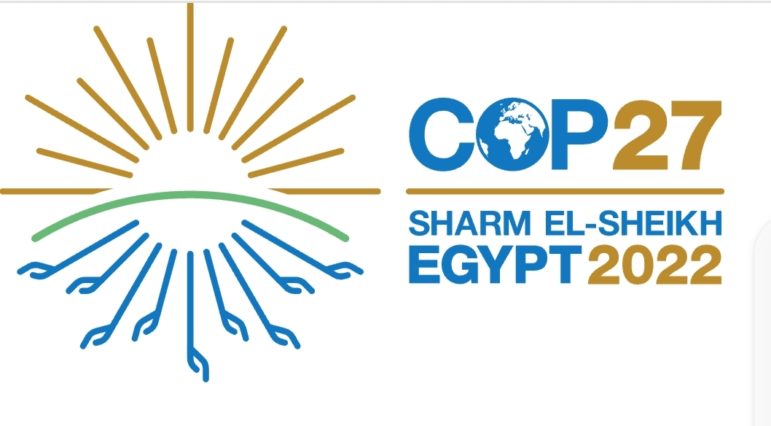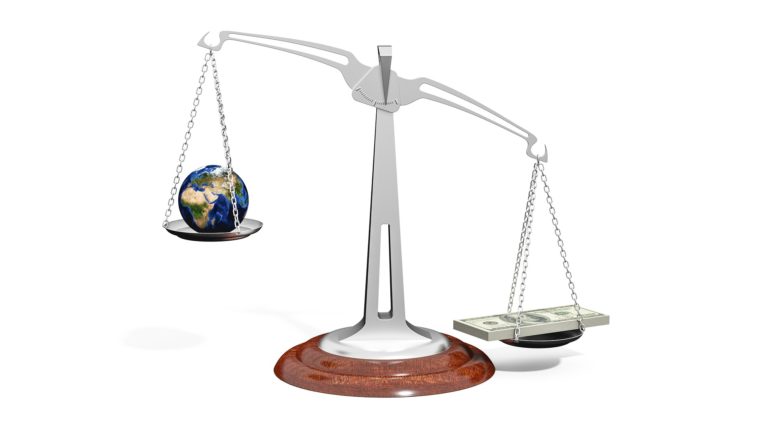TWH – The Paris Agreement of 2015 may be the most well-known agreement of the United Nations Framework Convention on Climate Change (UNFCC). Every year, its major decision-making body, the Conference of Parties (COP) meets to monitor progress on its agreements. This year marked its 27th annual meeting, hence the acronym COP27.

COP27 logo – Image credit: Raafat – CC BY-SA 4.0
COP27 took place in Sharm El-Sheikh Egypt from Nov. 6 through Nov 20, 2022, with more than 45,000 people participating.
On Nov. 20, the UNFCC announced that COP27 had agreed to a Loss and Damage Fund. The agreement would “provide loss and damage funding for vulnerable countries hit hard by climate disasters.” For years, rich and poor countries had disagreed on loss and damage funding. Wealthy countries would provide aid to poorer countries threatened by climate change.
Greenhouse gases in the atmosphere drive climate change and wealthy countries produced most of those gases. Their burning of fossil fuels allowed them to develop and build wealth. Damage from climate change, however, threatens poorer countries more than richer countries. Some of those poor countries are island nations in the Caribbean, the Indian Ocean, and the South Pacific. Rising sea levels present an existential threat to those island nations.
Despite opposition, COP27 kept the goal of limiting average global temperature rise to 1.5oC (2.7o F). Scientists theorize that any rise above 1.5o C (2.7o F) would be catastrophic to life on earth.
COP27 also developed the Sharm el-Sheikh Implementation Plan, which outlines steps to transition to a low-carbon economy. The plan has the potential to transform the global financial system. According to estimates, the plan will require $4 to 6 trillion per year.
Unfortunately, the developed world failed to meet its prior funding targets of providing $100 billion per year by 2020.
Difficult details
The agreement still has many difficult details yet to be worked out.
The New York Times reported on those details. A 24-country committee has one year to figure out three critical details. First, the structure and form of the fund; second, which countries should contribute to the fund; and third, what criteria will the fund use to distribute its funds.
The second point concerns China. Currently, the U.N. classifies China as a developing county. That classification would allow China to receive money from any “loss and damage” fund. It would also exclude China from having to contribute to the fund.
China now emits more greenhouse gases than any other country, and currently, its economy ranks as the second largest in the world. The U.S. and the E.U. want China to contribute to any “loss and damage” fund. China wants to maintain its status as a “developing country.”
The agreement also excludes legal liability for richer countries that default.
Other critical elements remain contentious. Countries failed to agree on a reduced amount for each country’s greenhouse gas emissions, as well as failed to agree on a goal of fully phasing out fossil fuels including coal, natural gas, and oil.
Pakistan leads developing countries
Pakistan led 134 developing nations in arguing for the “Loss and Damage” fund. This summer, Pakistan suffered extreme flooding with water covering one-third of the country. Deaths exceeded 1,500 people. Damages amounted to about $30 billion dollars. Pakistan’s annual contribution to greenhouse gases amounts to less than one percent.
In September, The New York Times reported on a recent study that Friederike Otto of Imperial College London led. She said that Pakistan “might have experienced disastrously high rainfall this year even without global warming.” Global warming made it worse. She continued, “especially in these highly vulnerable regions, small changes matter a lot.”
The European Union (E.U.) agreed to a Loss and Damage Fund with certain conditions. The EU argued that aid should only go to the most vulnerable nations, and also insisted on a variety of models within the fund. Specifically, they wanted it to include an insurance model. The U.S. agreed to a Loss and Damage fund at the end of the conference.
Calculating loss and damage is very complicated
Note, calculating monetary compensation for climate change damages is not an easy task. For example, assume rising sea levels threaten to submerge an island nation. The island rises just above sea level, with maybe a few hills rising 100 to 1000 feet above sea level.
Compensation could take many forms. Outlined below are just three out of many possible types of compensation.
The fund could pay to build a sea wall, expensive and precedent setting. The fund could pay to resettle the displaced islanders. Besides resettlement costs, the fund could compensate displaced islanders for loss of social capital.
Social capital refers to the many elements that create a community. Examples of social capital include the loss of ancestral burial plots, the loss of familiarity, and the loss of social networks on the islands. The fund would also have to assign a monetary value to each type of damage. Lots of areas exist for honest disagreements as well as areas for conflicts of interest.

Image credit: Arek Socha from Pixabay
COP27 focuses on governments and humans. Climate change threatens species that have adapted to specific ecosystems. It also threatens a large variety of species, especially those on islands, that can’t migrate to more friendly environments.
For Animists and Pagans, nature spirits are tied to specific ecosystems. A rock outcrop on land may become submerged. If so, will its nature spirits evolve and adapt? Will they become underwater nature spirits? Will they move to another area? Or will they simply cease to exist?
Friday, November 11 focused on decarbonization, one of the conference theme days Several industrial sectors which include steel, oil, gas, and fertilizers, produce large amounts of carbon.
The U.S. launched an initiative with Egypt to develop 10 GW (gigawatts) of new wind and solar energy. At the same time, Egypt will decommission 5 GW of natural gas-generating plants.
The U.S. Environmental Protection Agency announced it would expand its 2021 methane rule. Under that rule, drillers will have to “find and plug leaks at all the country’s 1 million well sites.” It also pledged to “reduce methane from the oil and gas industry by 87% and below 2005 levels.”
Egypt announced a program to decarbonize “existing oil and gas facilities across Egypt.” It has invested $2.4 billion in total decarbonization projects. Each year, these efforts have stopped the release of 7 million tons of CO2 emissions.
COP27 President H. E. Shoukry also spoke about “balancing the energy Trilemma.” He said, “Energy is one of the most carbon-intensive sectors in any given economy.”
That makes energy one of the most important areas for mitigating climate change. Shoukry continued, “Science is clear: global emissions need to be reduced by half by 2030, reaching net zero by 2050. To achieve this, we need to invest in new sources of energy that are clean, affordable, accessible, sustainable, and reliable.”
A key problem in transitioning to clean energy involves its financing and distribution. Renewable energy requires “low-cost power, efficiency, electrification, bioenergy with CCS and green hydrogen.”
Between 2000 and 2020, only 2% of investments in global renewables occurred in African countries. Only four countries received those investments. With 54 recognized sovereign states on the African continent, that amounts to 7.4% of all countries in Africa.
To learn more about COP27
For more information, COP27 has issued press releases on its theme days, and all the presentations and discussions that were live-streamed are available on the U.N. Climate Change channel on YouTube.
YouTube also has video interviews about COP27 that The New York Times conducted. “Heat, Drought, Oil and Gas: How Can the Middle East Build Climate Resilience?” Another video “How to Stop the Global Waste Cycle” discusses ways to reduce the crisis in waste management.
The Wild Hunt is not responsible for links to external content.
To join a conversation on this post:
Visit our The Wild Hunt subreddit! Point your favorite browser to https://www.reddit.com/r/The_Wild_Hunt_News/, then click “JOIN”. Make sure to click the bell, too, to be notified of new articles posted to our subreddit.
